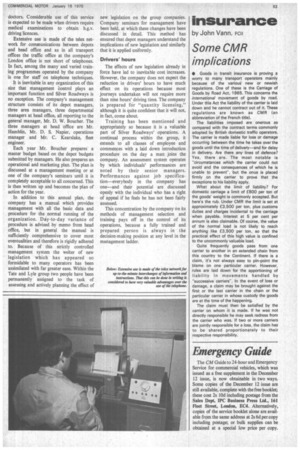insurance
Page 55

If you've noticed an error in this article please click here to report it so we can fix it.
by John Vann, FCII
Some CMR implications
• Goods in transit insurance is proving a worry to many transport operators mainly because of the various new or newish regulations. One of these is the Carriage of Goods by Road Act, 1965. This concerns the international movement of goods by road. Under this Act the liability of the carrier is laid down and he cannot contract out of it. These regulations are known as CMR (an abbreviation of the French title).
The liabilities imposed are onerous as compared with the contract terms commonly adopted by British domestic traffic operators. The carrier is made liable for loss or damage occurring between the time he takes over the goods until the time of delivery—and for delay in delivery. Are there any lines of defence? Yes, there are. The most notable is "circumstances which the carrier could not avoid and the consequences of which he is unable to prevent", but the onus is placed firmly on the carrier to prove that the exceptions to his liability apply.
What about the limit of liability? For domestic carriage a limit of £800 per ton of the goods' weight is commonly accepted. But here's the rub. Under CMR the limit is set at approximately £3,500 per ton, plus customs duties and charges incidental to the carriage when payable. Interest at 5 per cent per annum is also claimable. Of course, the value of the normal load is not likely to reach anything like £3,500 per ton, so that the practical effect of this high value is confined to the uncommonly valuable load.
Quite frequently goods pass from one carrier to another in an extended chain from this country to the Continent. If there is a claim, it's not always easy to pin-point the blame on one particular carrier. However, rules are laid down for the apportioning of liability in movements handled by "successive carriers". In the event of loss or damage, a claim may be brought against the first or the last carrier in the chain or the particular carrier in whose custody the goods are at the time of the happening.
The claim must then be satisfied by the carrier on whom it is made. If he was not directly responsible he may seek redress from the carrier who was. If two or more carriers are jointly responsible for a loss, the claim has to be shared proportionately to their respective responsibility.
































































































